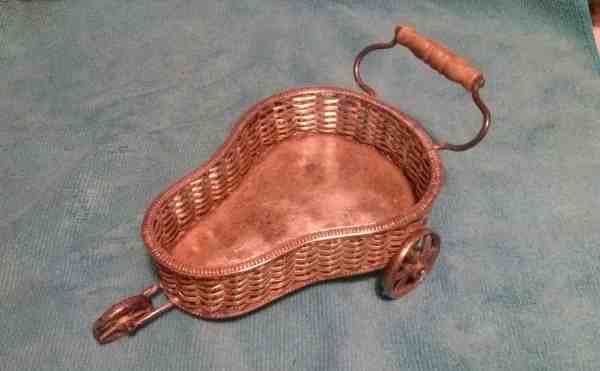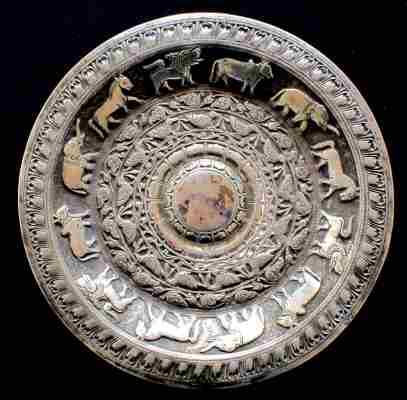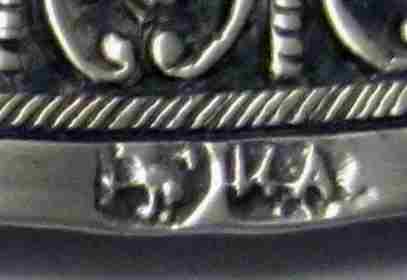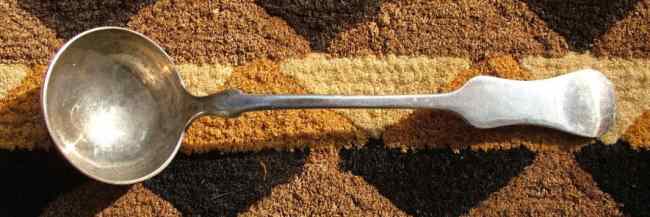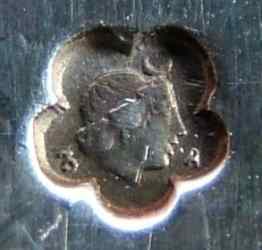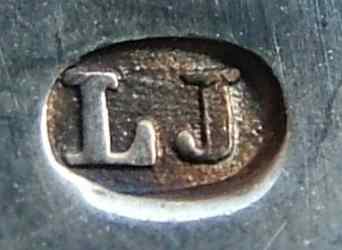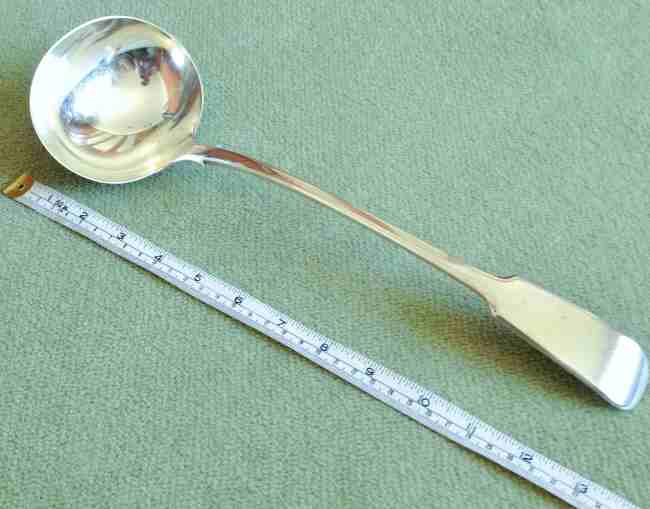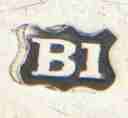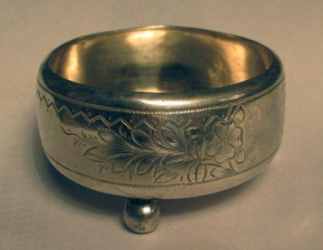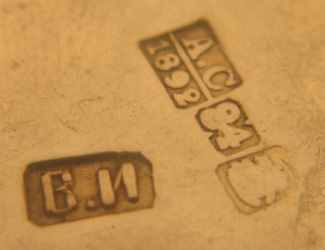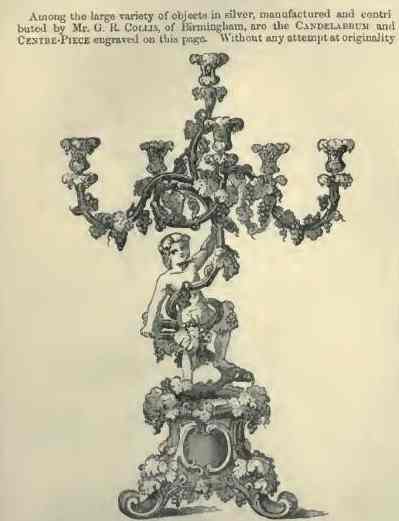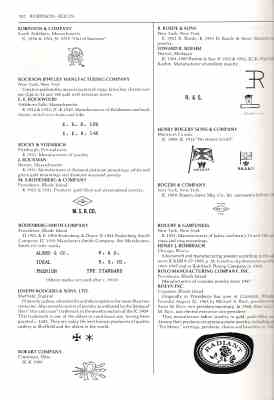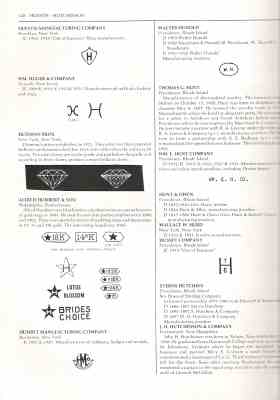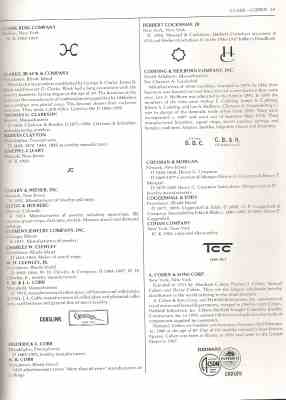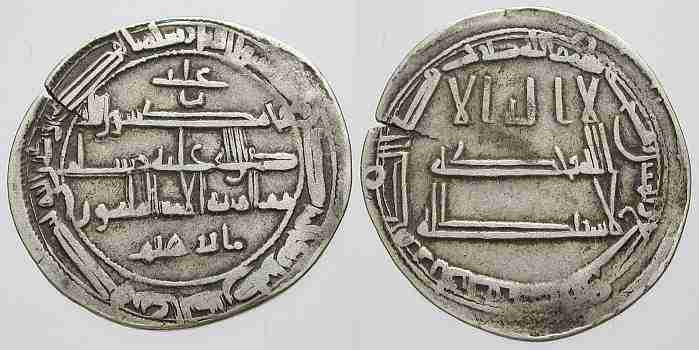
Lauren Chung presents:
To be a wise silver collector

Collecting antiques and old objects can be a thrilling
experience, as these objects take you to the ancient
times. You can visualize and re-live the history of a
particular era just by looking at the collectible item.
However, you need to be careful while investing in
antique silver collection, so that you do not end up
buying a fake item or pay more than its worth. Before
buying any collectible, it is advisable to go for
professional appraisal. Correct identification and
appraisal of an object help in insuring the object
against loss or damage. Besides, it gives information
about the historical significance of the object, how to
care for your possession and how to preserve it......
click here

|
Welcome to new ASCAS members:
Reg Lennox - Canada
Brian Lewis - Switzerland
Luke Regan - USA
Silvia Viruly - South Africa
Members' Window # 106
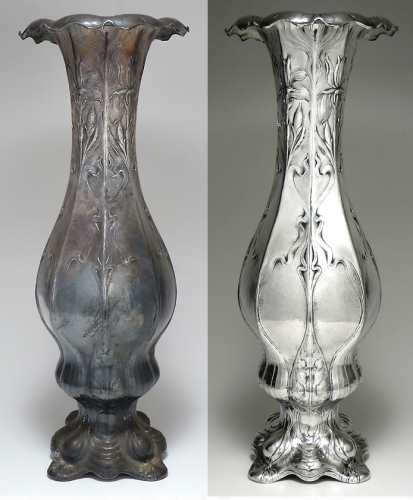
Jeffrey Herman presents:
Before and After on a Gorham MartelÚ Vase

This 76-ounce, 19" Gorham MartelÚ vase (design #1479)
was created in 1899 and is made of 950/1000 purity
silver.
I removed a small panel dent, leveled the feet, then
......
click here

|
Stefano Donaggio writes:
I need your help to identify an ancient silver salt (I believe
it's German).
Its measures are 19 cm long, 7.4 cm high, 11.7 cm wide, weight
213 grams. The shape is an oblong basket with three wheels and
an ivory handle.
I'd wish to know who is the maker and its age.
Thanks in advance
Stefano Donaggio
I don't believe that your "wheeled basket" is a salt. In my
opinion it is a decanter wagon or wine trolley. Information
about these objects is available in my website at
http://www.silvercollection.it/dictionarywinetrolley.html.
The mark isn't German but English and the metal is silverplate.
The maker is Roberts & Belk, Sheffield (see my website at
http://www.silvercollection.it/ENGLAROBERTS&BELK.html and
the date is late 19th century.
Giorgio Busetto
Gary D. Gardner writes:
I am a collector as well as independent scholar of American
Southern history & material culture, currently researching an
Inverness, Scotland trained silversmith named Robert Anderson
who emigrated to the US about 1819 when he appeared in Knoxville,
Tennessee.
I noticed that Mr. Robert Massart had supplied one on-line marks
reference with images of silver marks by this man's father or
grandfather who was active ca. 1760-1780. I didn't know if ASCAS
members have any biographical information on the elder
silversmith.
I think the younger Robert Alexander was born ca. 1756, but
again the smith who settled in America could be a grandson of
the Inverness smith.
Thanks so very much!!
Gary D. Gardner
Hodgenville, Kentucky
USA
Stuart Bennett writes:
Mote Spoon: An Original Theory
I have a very strong theory about the mote spoon and its usage.
My idea shatters the considered opinion that they were used in
relation to tea. My theory is as follows:
I think the mote spoon originated out of a drink that was and
still is, a Chilean beverage known as "Mote con Huesillo".
After voyages to the New World and South America I think this
fascinating drink would have brought back and taken up by the
gentry of the day. All the ingredients were available in the UK
at that time and would explain why it could possibly have been a
"fad" for less than a century.
The drink itself consists of cooked husked wheat, dried peaches,
sugar, water and cinnamon - where the peaches and wheat were
soaked overnight, then once hydrated cooked with sugar and water
and maybe a cinnamon stick.
Once put in a glass the sweet liquid (anything sweet was popular
in this era!) the wheat or motes sank to the bottom. Hence the
need for a long pierced bowled spoon to eat the motes and a
toothpick (the spiked end of the mote spoon) to remove the wheat
husks from the teeth.
I argue this point that if the mote spoon was meant for tea then
there would be far more of them in extant than there are, they
would be found made in other materials (for the less well-healed)
like plate, copper, brass or pewter - and they would have come
en-suite inside tea caddies.
I would be interested what your opinion might be?
Stuart Bennett, RA (Antq.)
An idea against the current thinking. Any comment by ASCAS
members will be welcome
Giorgio Busetto
Michael Thomas writes:
Sri Lankan Silver dish (sandakada pahana)
This piece of slightly tarnished Colonial silver shown in the
main photograph is repoussÚ work and the underside reflects this
exactly. It has been handed down but there is no clear
provenance. I have done some investigation and have little doubt
it comes from Sri Lanka, as it is similar to many other examples
from that area. The detail photograph shows two intriguing
stamped marks on the edge (one could be a stylised mythical
animal or body and the other looks like the letters &KA&).
I have two requests:
Can someone confirm (or deny) my view about its origin?
Throw light on the stamped marks?
Here are the main facts:
- Diameter: 160 mm
- Depth: 10 mm
- Weight: 142 grams
My view
The interesting design for this small dish is based on the
half-moon stone motif, which is found at the entrance to many
Buddhist temples in Sri Lanka and symbolises Buddha's journey
through life and the cycle of Samsara (birth, life, death and
reincarnation). The bands starting from the outside signify:
The rim - stylised flames and worldly existence.
The elephant - birth and growth, The horse - energy and effort
in the path of purification, The lion - power and teaching in
maturity, the bull - acceptance of death. There is an
alternative version.
The foliage (a liyavel) symbolises worldly desire.
Geese - examples of ideal qualities and understanding good from
bad.
The unfurling lotus represents the unblemished spirit or
nirvana.
Silver from the subcontinent is very difficult to pin down not
least because there are so few hallmarks let alone maker's marks
but I guess it dates from the early 1900s say 1920.
Here we have two clues so I would be grateful for any feedback
from other members.
Thank you. Michael Thomas
David Nikogosyan writes:
Dear Giorgio,
I bought a small ladle with two marks. One mark is a woman head
with a small digit 3 and a small letter A. Other mark is the
inscription LG.
Any idea about the maker?
Thanks,
David.
The ladle bears Austrian mark (1867/1922), town of Vienna
(A), silver fineness 800/1000 (3). The maker is Ladislaus
Jarosinski (active 1879-1903)
Giorgio Busetto
Willliam Coultas writes:
...I have this Walker & Hall silver plated ladle. It is quite
unusual as it is very large and I have never seen one so big.
I was a bit stuck on dating it I just wondered if you could help
me out.
Your help would be much appreciated.
Thanks
Willliam Coultas
Walker & Hall began to add the date letter to its
silverplate in 1884. Your mark is missing of the date letter and
moreover has a "crown", which use was forbidden c. 1895.
This suggests that your item was made before 1895 and before
1884. According to E.R. Matheau-Raven book this mark was used
1852-1897.
But I found some exceptions to these rules. In my webpage
http://www.silvercollection.it/ENGLAWALKER&HALLDATE.html you
can see a similar mark bearing the date letter "u gothic" which
according to P.A. Hulme book was used in 1913 (a series of
gothic letters used from 1912 to 1918).
My personal opinion is that your ladle was made in late 19th
century, but I'm unable to attribute an exact date.
Giorgio Busetto
Don Sheasby writes:
...I am attaching photographs of the marks on a Russian salt.
The Assayer's Mark belongs to Aleksandr Alekseevich Smirnov, but
I was unable to find the Silversmith's name corresponding to the
Cyrillic
 
If you do know who the silversmith is, I would appreciate your
input.
Regards
Don Sheasby
The maker of your Russian salt is Vasily Ivanov, active
1870-1908.
Giorgio Busetto
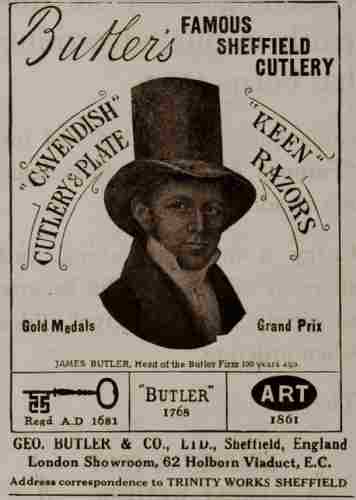
|
This month ASCAS presents an ancient advertisement
of:
GEO.BUTLER & CO LTD
BUTLER'S FAMOUS SHEFFIELD CUTLERS
"CAVENDISH" CUTLERY & PLATE
KEEN RAZORS
The firm was founded in 1681 and in 1922 was active in
its Trinity Works in Sheffield with Showroom at 62
Holborn Viaduct, London. George Butler & Co Ltd had a
wide range of patterns of stainless, silver plate and
sterling silver flatware. The firm used the trade mark
ART
This image is part of the
ADVERTISEMENTS IN SILVER - SILVER ADVERTISING
section of www.silvercollection.it website
|
"A WORD per MONTH"
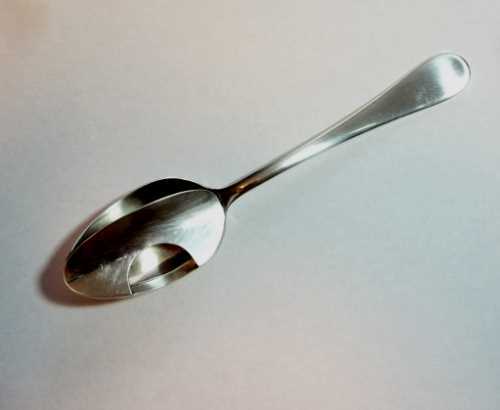
|
MOUSTACHE SPOON
MUSTACHE SPOON
A later addition to the mustache cup was the
mustache spoon, invented in the latter half of the 1800s
to allow the man to consume liquids without spillage
onto either the mustache or clothing.
The first patented mustache spoon was claimed in March
1868 by New York spoon designer, Solon Ferrer, and was a
soup spoon with a guard to hold the mustache free and
unsoiled of the liquid beneath it
In the letter patent No. 135,141, dated January 21,
1873, a mustache spoon is described as:
....the shield being such that, while it permits the
user of the spoon to receive into the bowl by the usual
dipping process a proper quantity of soup, the latter
can be conveyed to the mouth without any portion of the
liquid being brought into contact with the mustache....
The shield extends longitudinally from the tip of the
bowl to the point where the latter is united to the
handle, so as to leave about one-half of the bowl
exposed. The shield, however, is so cut away as to leave
an opening of such dimensions that it can be easily
overlapped and underlapped by the lips, and yet permit
the contents of the bowl, when the latter is tilted, to
flow freely into the mouth....
more
|
"A SILVERSMITH per MONTH"
|
|
GEORGE RICHMOND COLLIS & CO
successors to SIR EDWARD THOMASON
Sir Edward Thomason
(c.1769-1849) was a dominant and memorable figure in
Birmingham industry.
He was the son of a bucklemaker and apprenticed in
Matthew Boulton factory. In 1793 he set up a shop in the
button trade, diversifying and expanding the business
into gold, silver and medals. In 1806 he entered a
hallmark in Birmingham Assay Office as Thomason & Co. In
1810 Thomason extended his factory starting the
production of close plated knives, forks and spoons.
In 1817 Thomason entered into an agreement with James
Mudie to strike a series of medals recording British
victories over Napoleon; the dies were engraved by
English and French artists, and the results were
published by Mudie in An Historical and Critical Account
of a Grand Series of National Medals (1820). Thomason
subsequently purchased the dies.
In 1819 he began a series of forty-eight medals of the
Elgin marbles in the British Museum, which was completed
by 1823. In 1828 his workmen finished a series of
sixteen medals on scientific subjects, and two years
later sixty medals on biblical subjects. Developing his
usual practice of presenting medals to important figures,
he sent examples of the biblical series to all European
monarchs, as well as to the president of the United
States and the emperor of China....
more
|
"A BOOK ON MY SHELF"
In this column we present books, new
or ancient, dealing with silver in all its aspects (history,
marks, oddities...). This isn't a "book review" but only a fair
presentation of some useful "tools" that anyone may have in the
shelf of his bookcase.
ASCAS members are invited to contribute to this column
(click to enlarge images)
In the "book on my shelf" of this month ASCAS presents:
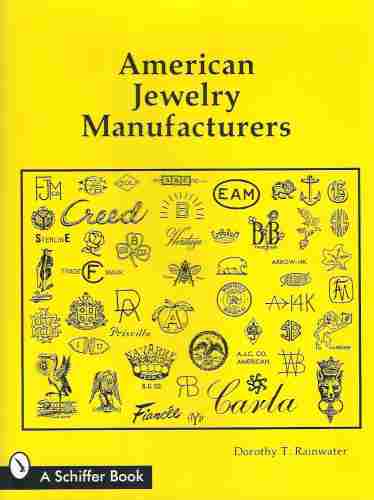
|
AMERICAN JEWELRY MANUFACTURERS
by Dorothy T. Rainwater
Schiffer Publishing Ltd - Atglen PA
1988
The identification and dating of American
jewelry herefore has been difficult because few
pieces bear standard markings and the references
have been diverse, hard to find, and incomplete.
Using old trade journals and their related
directories as her primary sources, the eminent
silver historian Dorothy Thornton Rainwater has
exhaustively compiled here for the first time a
comprehensive reference of jewelry trademarks and
manufacturers in alphabetical order. She has also
written a history of jewelry making in the United
States which explains the framework upon which this
enormous industry was built- The large scale
manufacturers which began in the 1840's form a major
portion of this directory. It is surprising to learn
that only in 1961, after years of effort by the
Jeweler's Vigilance Committee and the backing of
trade journal, did American law require makers'
marks on new jewelry. Therefore, this reference
should become an important sourcebook for every
jeweler, collector, antique jewelry dealer and
manufacturing historian for the foreseeable future.
|
Closing our APRIL 2014 edition of ASCAS Newsletter I hope
you have appreciated its content.
Your comments, suggestions and advice will be of great help.
My thanks to Stuart Bennett, Lauren Chung, Willliam Coultas,
Stefano Donaggio, Gary D. Gardner, Jeffrey Herman, David N.
Nikogosyan, Don Sheasby and Michael Thomas for their precious
contributions.
Giorgio Busetto
Secretary
DISCLAIMER AND PRIVACY POLICY
ASCAS is a community of people having a common
interest in antique silver.
It is a non-profit association without commercial links.
Membership is open to whomever has a true interest in
this subject matter.
ASCAS has no real property and no fees are requested nor
accepted from members.
ASCAS keeps in touch with its members only through
periodical newsletters, e-mails and web-site updating
and ignores and is not responsible for any other
activity pursued by its members.
Likewise, ASCAS is not responsible for opinions,
evaluation and images displayed, and in any form
published or supplied for publication, by its members
who, in any case, maintain the property of their works
and assure the respect of national and international
legislation about Intellectual Property.
ASCAS does not have the full addresses of its members (only
town, country and e-mail address are requested for
membership).
ASCAS handles and protects with care its members' e-mail
addresses, will not disclose the addresses to third
parties, will use this information only to reply to
requests received from members and for communications
strictly related to its activity.
These rules are expressly accepted by submitting the
membership request.
|
|
 newsletter
# 119 April 2014
newsletter
# 119 April 2014











